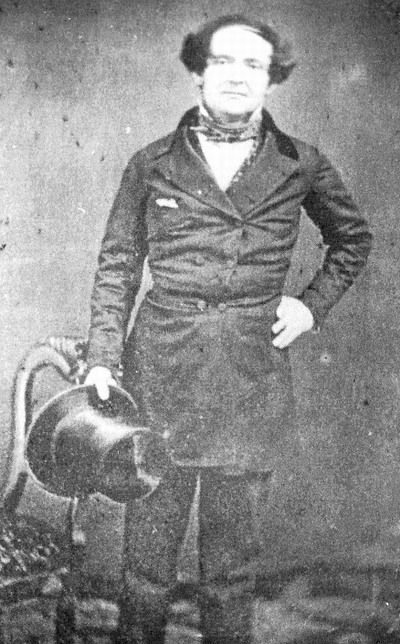
Michael H. Simpson (1809-1884). Thanks to Images of America, Framingham.
Michael Hodge Simpson was a son of Massachusetts, born in Newburyport on November 15, 1809, the son of Abigail Hodge and Paul S. Simpson.
By the time he was twenty-one he was in the Calcutta, India and Buenos Aires, Argentina, South America trade dealing in hides, horn, and wool. At the age of twenty six, in 1835, a period of change began that quickly redirected his career and set the pattern for the next fifty years. He had a problem. He is said to have had one million pounds of burry wool (raw, dirty, low grade) on his hands.
In 1835 he advertised for machinery to deburr his wool. He did not like any of the offerings, but took one of Couillard's machines. He had established his own mill (the Simpson Worsted Mill, location unknown but perhaps Roxbury) and with his mechanics, improved on Couillard's patent so that when it removed the burrs it did not cut the staple (fibers).
At this point, he sold his import business to [the] principal owners of the Saxon Factory in Saxonville. He moved his machinery to Saxonville and became part owner. In the panic of 1837, the company had financial problems and Michael became its principal creditor. He was elected General Agent (Manager) of the two companies involved, The Saxon Factory Co., and the New England Worsted Co. The N.E. Worsted Co., which produced carpet yarn, had originally been in Lowell and may have had control of the patents that were issued there.
He married Elizabeth Davies Kilham of Boston and daughter of Jeremiah Kilham (who was involved in the clothing business).
The Roxbury Carpet Co. was formed when, in 1854, Michael met John Johnson, an Englishman operating mills in Troy, N.Y. and a textile expert who had perfected tapestry carpet power looms. Michael had the looms installed in the Roxbury mill and Johnson was made Manager. [However, Roxbury Carpet Co. did not move to Saxonville until 1919.] The line was very successful and was the company's line until its closing in 1973.
Excerpt taken from the Fall 2001 newsletter available at the friends of Saxonville.
[In the 1850s], continuing to keep up with modern methods and exercising his inventive urges, Michael received a patent, #16864, for a wool combing machine. This was another improvement on Couillard's original machine. It added combing to the deburring process. The machine was larger and made of metal instead of wood. His contemporaries felt that his machines were the basis for much of the American wool industry. However, the Saxonville mills failed again in the panic of 1857. This time Michael stepped in and took full control. He convinced Nathaniel Francis to join him in buying up the entire Saxonville and Roxbury operations. Michael bought up two thirds and Francis took the other third.
[On Feb. 7], 1859, Michael's eventual business successor was born as Frank Ernest Simpson.
In 1871, we find Michael is still listed as Agent, and now principal owner of the Saxonville Mills. J.W. Blake is Treasurer and John Simpson (a cousin) is superintendent; 475 hands are working at the mills, and there is a Boston office at 127 Milk Street.
[He] was also building a great deal of housing for the mill operatives, for which they would pay him rent. In January, 1872 there were more than sixty applications for this housing. In February, Number One mill burned to the ground, and it was feared for a while that the whole village would go up in flames. The villagers and mill hands put the fire out. They protected some of the nearby mill buildings by spreading wool blankets on their roofs and soaking them with water. One of the large row houses at the foot of Danforth Street was finished in October. It was described as 30' x 140' and as having seven tenements (it still has seven front doors). The building projects continued into 1873 when the newspapers commented that Michael appears to want them to be models of comfort and convenience.
On June 23, 1878, his wife Elizabeth suddenly died.
The year 1880 was a happy one for Michael and the village of Saxonville in regard to one family matter. After a year in Harvard Law School, Frank [Ernest Simpson] decided to forsake a career in law and devote his life to the mills and the village. The mills in Saxonville were producing white and gray blankets, worsted carpet yarn and haircloth overcoats. Frank decided to stay in the village through the winter to learn the business better. [Frank would later take over the Presidency of the mills].
The climax of Michael's life and career began in 1882. On June 1st he married a twenty-seven-year-old Saxonville woman named Evangeline E. Thurston Marrs; he was almost seventy-three. They were married by Rev. Lucius Eastman of Framingham and the wedding was quite an affair according to the newspaper. They went off to Europe for their honeymoon. He ordered the construction of an enormous mansion for her, overlooking the Dudley Pond on Old Connecticut Path, just over the town line in Wayland. It was 50' x 200' and cost about $150,000 (the equivalent of several million dollars today).
Excerpt taken from the Winter 2003 newsletter available at the friends of Saxonville.
After Michael's death, Evangeline Simpson became a dear friend of Rose Cleveland, sister of President Grover Cleveland. Well, maybe it was a bit more than friendship.
"Dear friend", indeed! :-)
ReplyDeleteRose served as "First Lady" for her bachelor brother, Grover Cleveland. She is buried in Italy, alongside Evangeline. The two had lived there together for some years.
Delete